Where’s the best place to shoot a coyote? If you are a new predator hunter, you already probably asked a few friends this question. So, how many answered your shot placement question with “Just behind the shoulder” or “Center mass”?
It isn’t until our first coyote walks out of the brush and into view that you realize something is wrong with this great advice.
Your coyote never stops moving. Your heart is racing, and you are gasping for air like you are being waterboarded. And just where in the hell are a coyote’s shoulders?
The next few minutes of your hunt will go like this: You will struggle to keep your bobbing reticle on a constantly moving target. Finally, you’ll zoom in your scope so close you can see individual hairs on the dog. The moment the lolling reticle drifts back onto the dog, you’ll yank the trigger back.
As the rifle recoils, your scope will lose sight of the coyote, and you’ll spend a few seconds dialing back down the magnification and desperately trying to find the place the coyote was when you fired.
Probably the cheapest, most reliable, and easiest to use night vision equipment I have ever bought are these night vision binoculars. If you want to see fox in the dark and shoot them, you can buy an infrared scope or thermal scope (pricey!)—and put it on a .22 or larger. I own, use, and recommend all three of these products and bought them from Amazon.
Looking for a great book on how to call in a coyote? Check out Andrew Lewand’s book below. This book answers the most frequently asked question on the internet… What sounds are working right now? No matter which brand of call you use, the sequences in each chapter with boost your success rate!
The best place to shoot a coyote?
For you, the best place to shoot a coyote will depend on several factors what you intend to do with the pelt, what ammo you will be using, and where you place your shot.
Why are you hunting coyotes? Your answer to that question will determine your ammo selection and the aiming point you will use.
You want to bag a coyote? Build them a deli! Read my article on how to build the perfect bait pile.
Coyote shot placement for taxidermy mounts.
If you want a standing, full-body mount, you’ll need to prevent as much damage as possible. Therefore, you will need to shoot the smallest caliber round in a location that results in the least amount of mutilation to the hide.
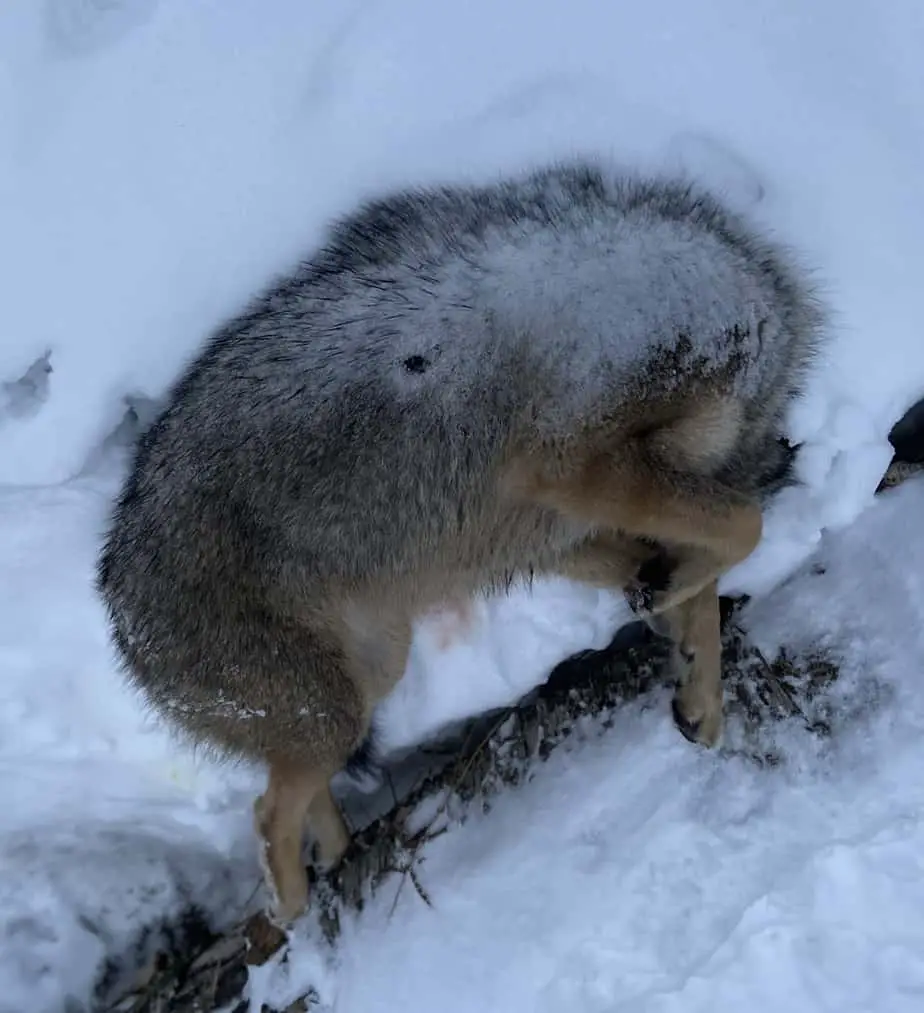
Mounts are not just for your hunting room. Keep in mind, even with fur prices down, the option to sell your mount still exists, and there is a market for them.
If you will be looking for a head and shoulder mount only, you can use a larger caliber round and place your shot anywhere behind the shoulders.
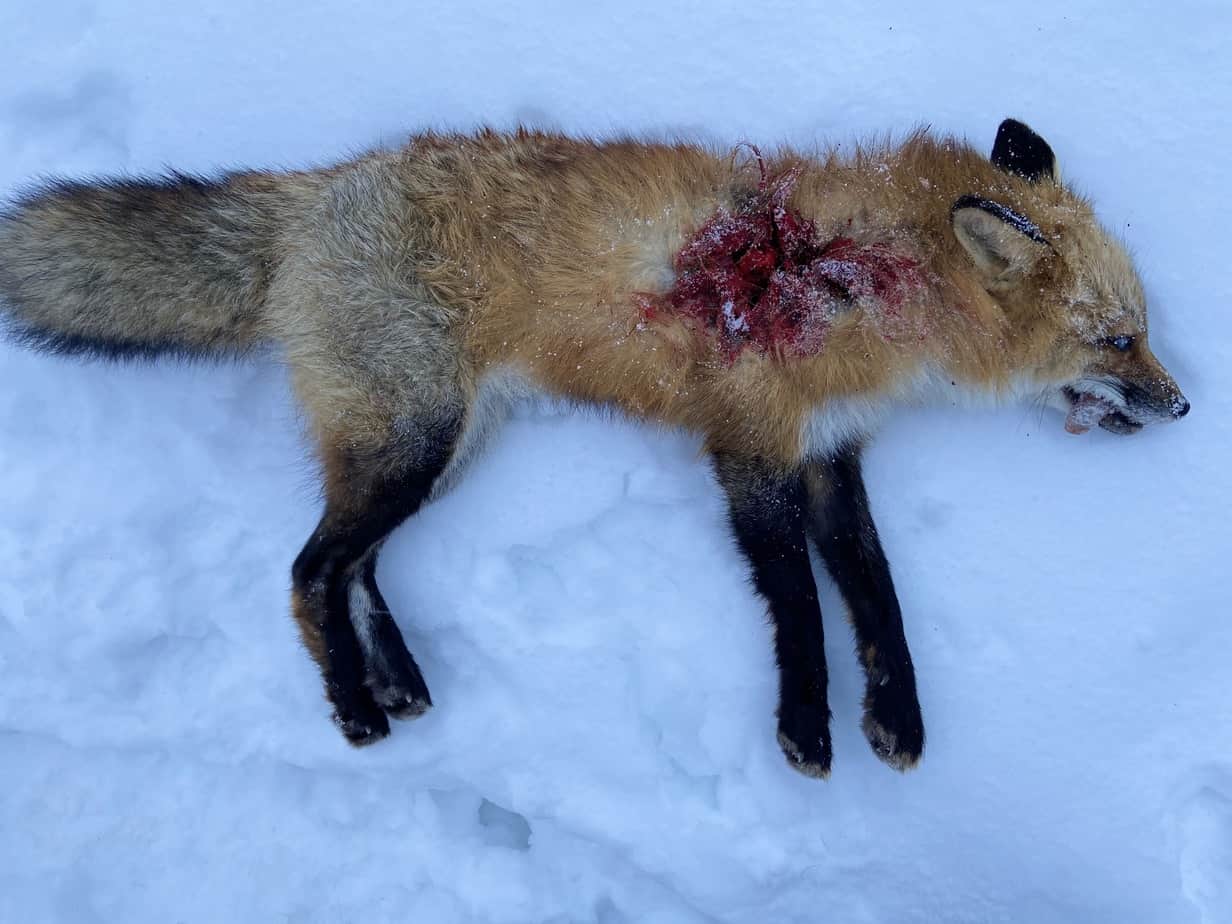
Where to shoot a coyote for pelt wall mounts and rugs.
As long as the exit wound is repairable, pelt wall mounts and rugs remain an excellent option. You can save some costs by watching out for shots that hit the spine or the top of the shoulders—these can cause severe pelt damage even with smaller rounds. While location is not as important, the caliber used will be.
Where to shoot a coyote when the hide won’t be saved.
If you do not intend to save the hide, the ammo you use and the placement of the shot don’t matter. Outside of how long you’ll need to track a wounded coyote, anything goes.
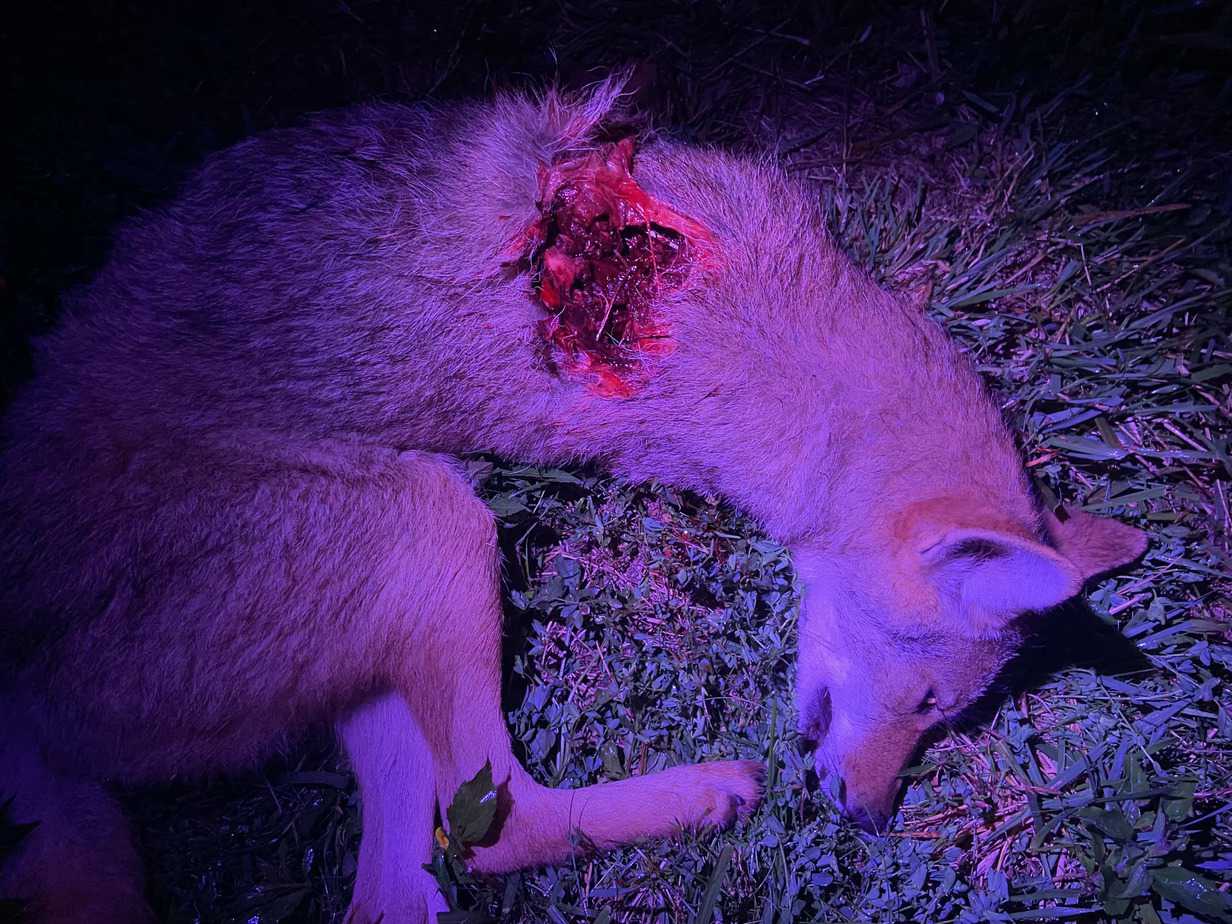
When are the coyotes you hunt most active? When are they going to be most likely to respond to your calls? Read my article on best hours to hunt coyotes.
Where to shoot a coyote: Ammo selection.
Important notice: There are no ads or product links in this section. However, I have included a link to Hornady’s Rifle Ballistics page to help you do further research on your own.
As this website is primarily for new predator hunters, I’ve also limited the ballistic information to 300 yards.
Shot placement on coyotes: Minimum foot-pounds
The critical factor to consider is the kinetic energy (foot-pounds) your bullet will strike the coyote with upon impact. For simplicity, I use the often suggested minimum of 10 ft/lb per pound to create a lethal hit on a coyote.
In the United States, the average weight of a coyote is 30lbs. At 10 ft/lb per pound, that means you should use a bullet that delivers at least 300 ft/lb upon hitting your target.
Note: If you live in areas populated by Eastern Coyotes, where some dogs can weigh 60-70 pounds, you’ll need at least 700 ft/lb.
Check the information on the side of your ammunition box to determine the maximum distance you use your ammo at and still deliver this critical energy.
Shooting coyotes with FMJ.
New predator hunters should know that FMJ means Full Metal Jacket. FMJ rounds are perfect for Marines shooting enemies hiding behind light cover—the jackets help pierce that cover—but not for predator hunters.
FMJ or “target” labeled rounds do not expand on contact with coyotes. These bullets often pass through the animal’s body without deforming and opening a more effective wound channel. As a result, many coyotes hit by FMJ or target rounds are not instantly killed.
Never use target or FMJ rounds on coyotes; it’s inhumane.
Shooting coyotes with .17 HMR and .22 LR.
Unless your marksmanship is excellent—unlikely if you are a new predator hunter with a heart rate over 130–these rounds are not suited for coyote hunting. Folks will tell you the .17HMR can drop a coyote in its tracks under 50 yards. True, but what they don’t brag about are the coyotes that run off with injuries or the headshots that get missed.
In the video below, it takes three hits to kill a smaller coyote. This proves the round is too small for regular coyote hunting.
Ballistics example: The 17 Hornet 20 gr V-MAX Superformance Varmint
At 100 yards, this round delivers 421 ft/lb. At 200 yards, the number is 294 ft/lb, technically below your suggested 300 ft/lb minimum.
Shot placement with .22 Magnum.
An excellent round for squirrels, and it is capable of killing coyotes under 50 yards away. The problem for new predator hunters? You probably have a .22 LR rifle. Unfortunately, a 22LR cannot chamber the .22 Magnum.
In the video above, they use a 22 Magnum at very close range.
Ballistics example: 22 WMR 30 gr V-MAX®Varmint Express® Rimfire
At 100 yards, 134ft/lb. At 200 yards, 67 ft/lb.
Where to shoot a coyote with the .204 Ruger?
With minimal pelt damage, lack of recoil, extreme accuracy, flat trajectory, and the fact it is marketed as a predator round, what’s not to like? Well, I’ll bet as a new predator hunter, you never even heard of this caliber, let alone have one. If, however, you do, its slowest round travels at 3,900 fps, and it’s perfect for you.
This video shows it’s incredible accuracy a long
Ballistics example: 204 Ruger 24 gr NTX®Superformance® Varmint
At 100 yards, 717 ft/lb. At 200 yards, 494 ft/lb, and at 300 yards, 334 ft/lb.
The 22-250 kills but shot placement on coyotes is critical.
At 3,700 fps with a 55-grain projectile, the 22-250 provides 20% more foot-pounds of impact energy than a similar-sized round fired from a .223.
The drawbacks to using the 22-250? It’s more expensive than the .223 (more than 200%) and hard to find during shortages. It is also often a terrible round on pelts. Finally, if a bobcat shows up to your calls, you’ll likely bring the taxidermist a clump of bloody rags no matter where on the body the bobcat is hit.
22-250 Rem 50 gr V-MAX®Superformance®
At 100 yards, 1373 ft/lb. At 200 yards, 1057 ft/lb. At 300 yards, 806 ft/lb.
The .223: If there was a winner, it’s this round.
The .223 is one of the most common predator rounds in use today. That popularity is among the best rounds for new predator hunters regarding availability, down-range performance, price, and limited pelt damage.
In this video we have a 223 in the hands of an excellent marksman.
Ballistics example: 223 Rem 55 gr V-MAX®
At 100 yards, 995f t/lb. At 200 yards, 763 ft/lb. At 300 yards, 576 ft/lb.
The .243: Shot placement is vitals to save the pelt.
If you hunt where it is windy and get good with your marksmanship skills, the .243 will let you knock coyotes down at 400 yards. The 90-100 grain bullet (nearly twice the weight of a .223) is often used on Whitetail deer, but it works like it was made for coyotes.
Ballistics example: 243 Win 58 gr V-MAX®Superformance®
At 100 yards, 1546 ft/lb. At 200 yards, 1199 ft/lb. At 300 yards, 921 ft/lb.
Are you hunting eastern coyotes? Need some tips? Check out my article on Hunting Giants.
What’s the best type of bullet to shoot a coyote with?
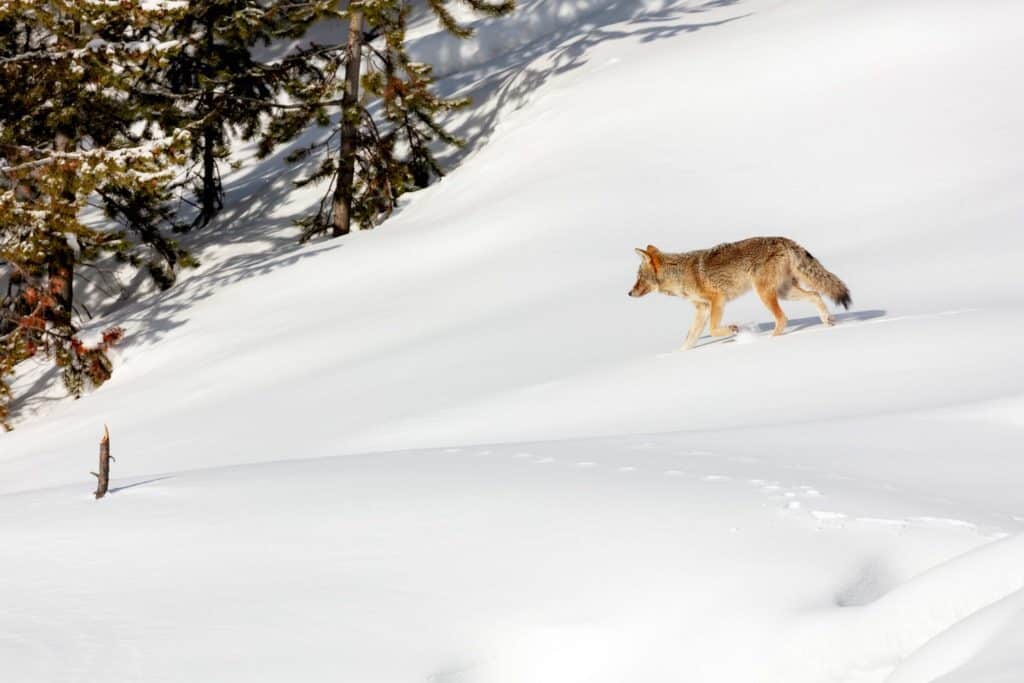
If you are a new predator hunter, save yourself a lot of trouble for now and use a round explicitly made for varmints. Varmint rounds, often featuring a polymer tip, are designed to enter the coyote, basically explode inside, and instantly kill the animal without leaving an exit wound.
In reality, many shots don’t go as planned. For example, bullets sometimes strike shoulders and other heavy bones, causing a “splashing” effect. Coyotes wounded this way run off and need to be tracked.
Where to aim to hit the best place to shoot a coyote.
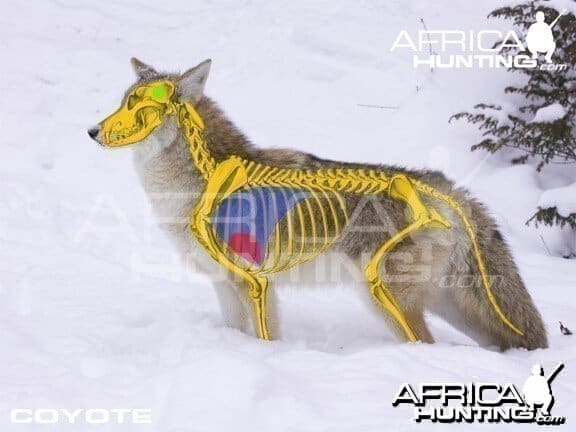
Thanks to https://www.africahunting.com/, a new coyote hunter can finally get an idea of just how small the Dead Right There (DRT) target zone is on a coyote.
And DRT is always the goal of an ethical predator hunter. DRT is humane, requires no tracking, and is the ultimate testament to your skills as a predator hunter and a marksman.
As you can tell from the photo, the vitals zone (heart and lungs) is small compared to the rest of the body. The fur on a coyote creates a much larger target in the mind of a hunter. The sheer size leads many first-time coyote hunters to take “center mass” shots. However, a center mass shot misses the vitals and leads to a DMA (dead miles away) coyote.
Looking again at the photo above, you can see any shot aimed “just behind the shoulders” leaves the shooter with a small, hard-to-determine target zone. Even if ideally taken, such a shot will hit the spine (dropping the dog but not instantly killing it), or worse, hitting the shoulder blade and causing the round to splash against the bone (DMA).
Shot placement on a coyote: A few expert tips.
Never take a shot at a moving coyote.
It takes a lot more skill to place a shot in a 6” target zone that is moving than one that is as still as a paper target hanging on a post. Add some adrenaline, a thumping chest, and some excited, trembling muscles—and you are guaranteed to miss.
The good news here? Just about every fox or coyote has one fatal flaw; they are curious. Well, maybe even nosey. So if you bark, whistle, yelp, or even shout, “Stop” at them, they will halt in their tracks and turn their heads in your direction.
The idea of deliberately making a loud noise when predator hunting may seem foolish to a new coyote hunter, but at the right moment, it works.
Here are a few tips to help you make your bark, whistle, lip smack, or woof stop the coyote, but not scare it off.
- Use just enough volume to reach the dog. You want to get its attention, not startle it.
- Raise the volume and keep trying to stop the dog. Be prepared to have to issue several stop noises.
- If the dog stops and starts moving before you can get your crosshairs on it, make more noise. Most foxes and coyotes will stop several times, providing you with additional shooting opportunities.
- If the dog spooks and starts fleeing the scene, rather than taking a wild shot, go crazy on your volume. A loud bark or woof may work, especially if the dog thinks it has moved away from immediate danger.
Watch how many times this fox stops before presenting the perfect target.
If you are new to predator hunting please check out my free guide here.
A bait pile is the only other guaranteed way to get a coyote or a fox to stand still. So if you are looking to attract and hold predators, try this article on creating the perfect coyote bait pile.
An inside look at the best place to shoot a coyote.
The truth is the heart and lungs (the vitals zone) in a coyote or a dog are behind the shoulder joints and centered above the forelegs.
This 6” zone, when properly hit with a varmint round, will cause DRT coyotes the majority of the time.
The problem for any new predator hunter is finding the aiming point when the coyote isn’t facing broadside.
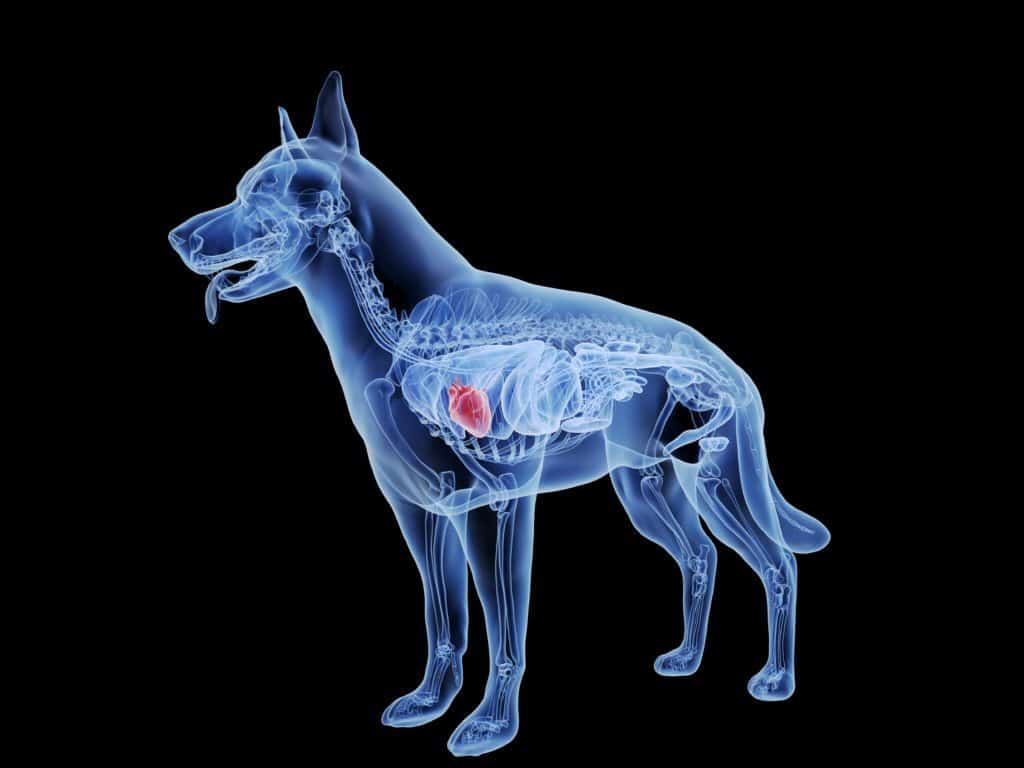
Coyote shot placement: Best place to aim when quartering toward you.
At first glance, a quartering toward shot looks less favorable, but by aiming for the midpoint 6” above the top of the foreleg, your shot is more advantageous.
With the target presented this way, there’s less risk of a splash against a bone, and you have a cleaner shot at the vital organs.
Coyote shot placement: Best place to aim when facing front.
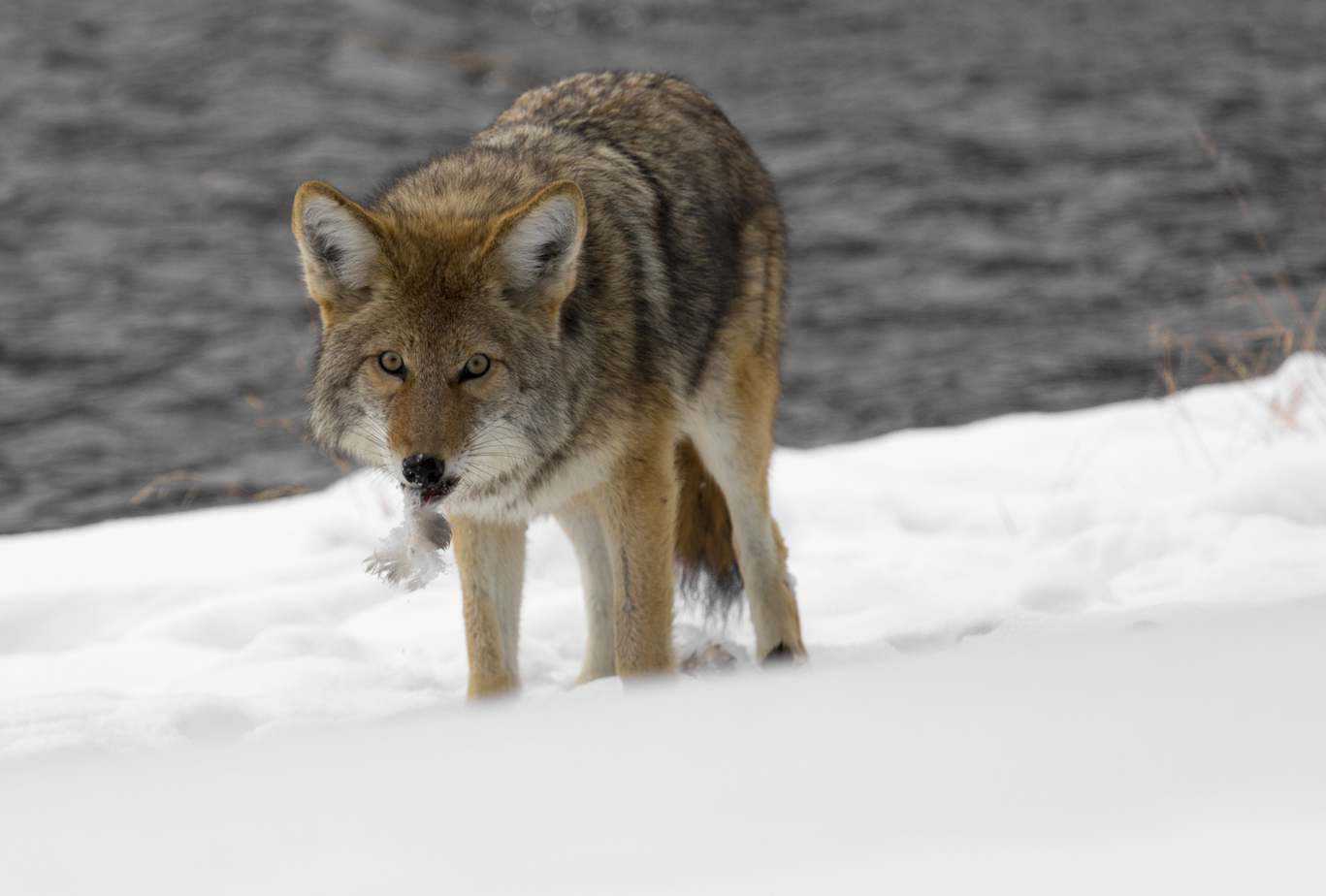
Many coyote hunters consider the facing front to be their favorite shot, especially for long-range targets.
The reason for this is simple, a coyote, especially a seated one facing you on a windless day, doesn’t require excellent distance judging on your part. Therefore, a forward-facing target gives you more room for error as any bullet drop will still connect and produce a DRT.
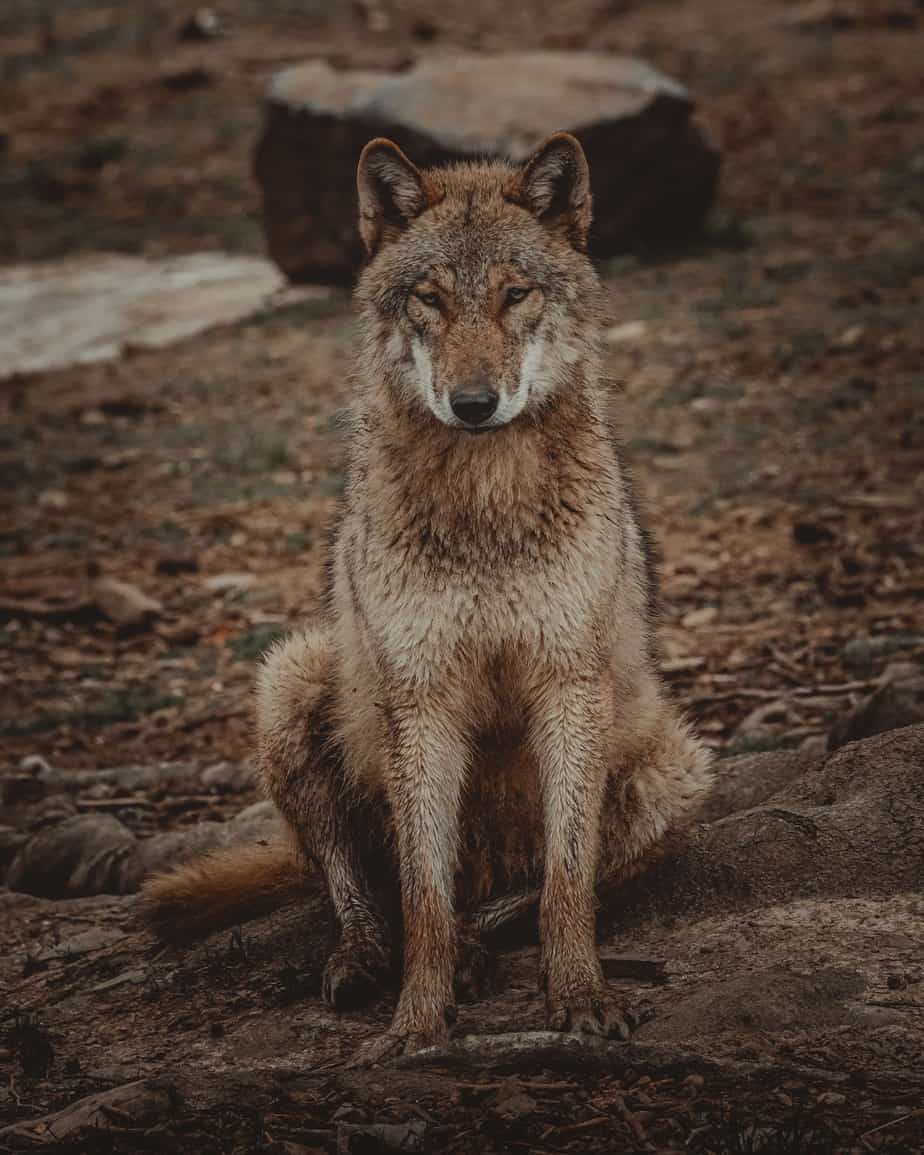
The aiming point on forwarding facing coyote can be the tip of the nose for long shots or the top of the head for even longer shots.
However, for a new predator hunter, a coyote directly facing you presents a difficult target for DRT hit, even at close range, as seen above. The coyote’s vital zone is smaller when facing forward, and all the fur surrounding it isn’t essential.
If you find yourself with a coyote staring at you, your best opportunity for a shot will be to wait until it begins to turn away, and take the quartering toward you shot.
Coyote shot placement: best place to aim when quartering away.
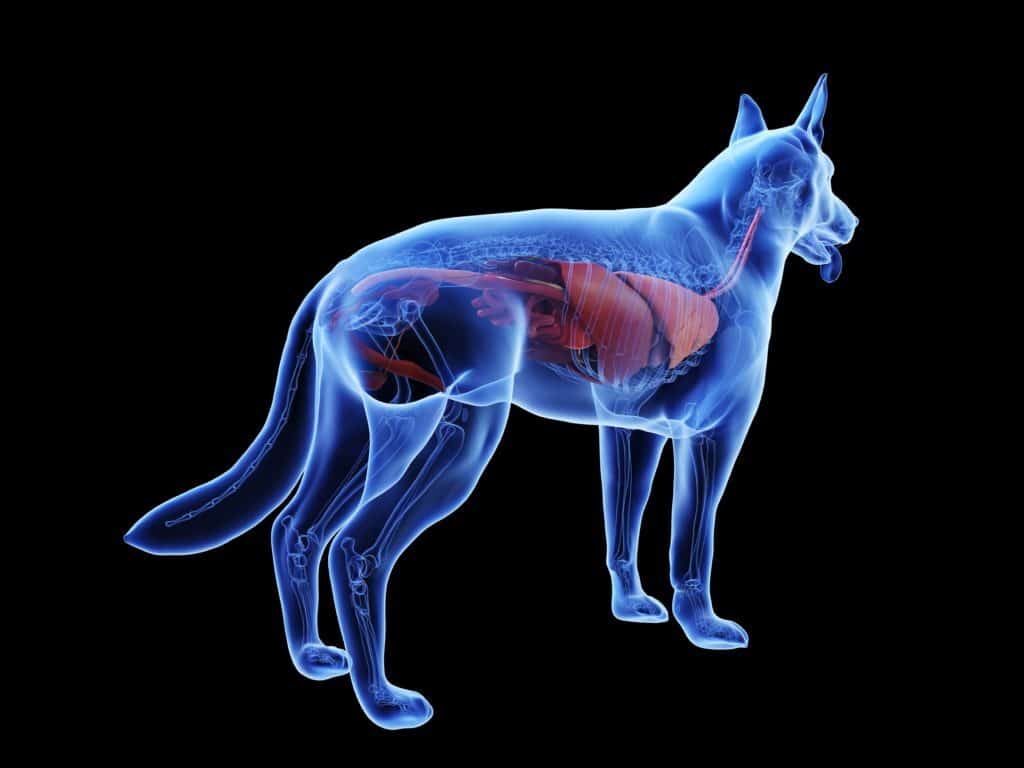
The quartering away shot virtually reduces any chance of striking a bone, opens up vitals for a clean shot, and even if the round fails to open up and passes through, it creates a much longer wound channel than a broadside hit.
The quartering away shot is my favorite and produces some dramatic DRT results.
The head is not the best place to shoot a coyote.
The only time you should ever aim for a coyote’s head is when you need to compensate for bullet drop. But please, never take a deliberate headshot.
One of the first things you will discover as a new predator hunter is how to tell a predator from any other animal at long distances or in low light conditions: if it stands still, it isn’t a predator. A coyote is constantly moving, and even when you get it to stop, the head will still be on a swivel.
When you aim at the head of a coyote, the only DRT result you can hope for is if you hit the brain. That brain sits in a skull about 8 inches long and measures only a few inches itself. So it’s a tiny target.
Headshots are low probability and unethical.
If you miss the brain and still hit the head, you’ll probably cause a terrible wound, and the coyote will need tracking. Sometimes, the round will hit the skull and knock the coyote out. However, these otherwise unwounded dogs can give you quite a surprise when they suddenly rise from the dead.
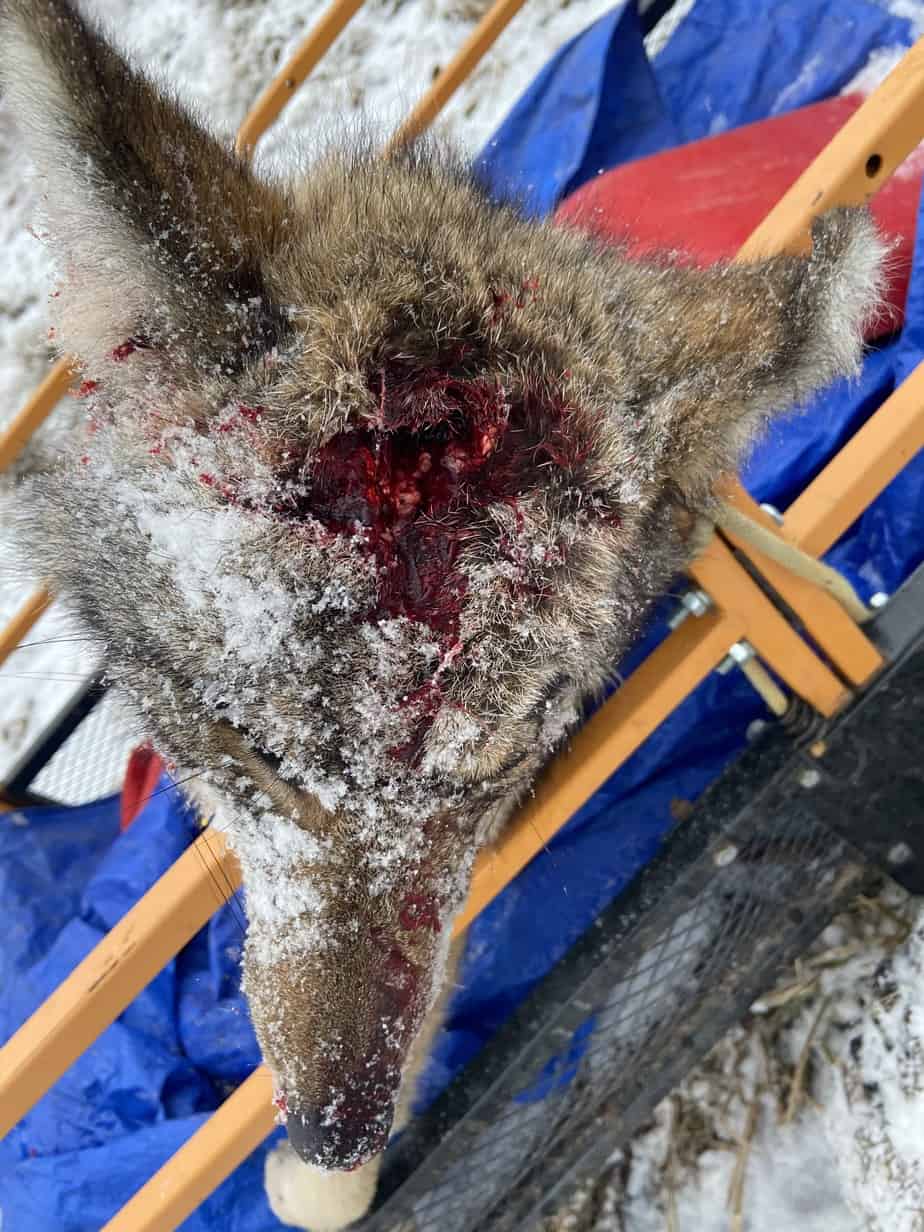
You will miss it if you still decide to aim for the head as a new predator hunter. When you get a few seasons of experience under your belt, you’ll still mostly miss.
One day, however, you will take a headshot, and after the coyote runs off, you will find half of its jaw or two inches of its nose. Then, if you are an ethical hunter, you’ll spend the rest of the day trying to find and finish that dog off. And, you’ll never take another headshot.
Coyote shot placement: Bullet drop and holdover.
Whether you realize it or not, this is the information you were seeking. But, unfortunately, at anything over 200 yards using the calibers listed above, merely placing your reticle where you want the bullet to hit won’t work.
As your round sheds its energy and speed, the law of gravity starts to be enforced. The result is called “bullet drop,” and it saves more coyotes than unseen twigs and strong winds combined. Compensating for bullet drop is easy, however, especially for new predator hunters who will be hunting with just one rifle.
Know your bullet’s drop at 300, 400, and 500 yards.
I know this website’s focus is on helping new predator hunters. New coyote hunters shouldn’t be reaching out that far, fair enough. So, let’s call this information “for training purposes only.”
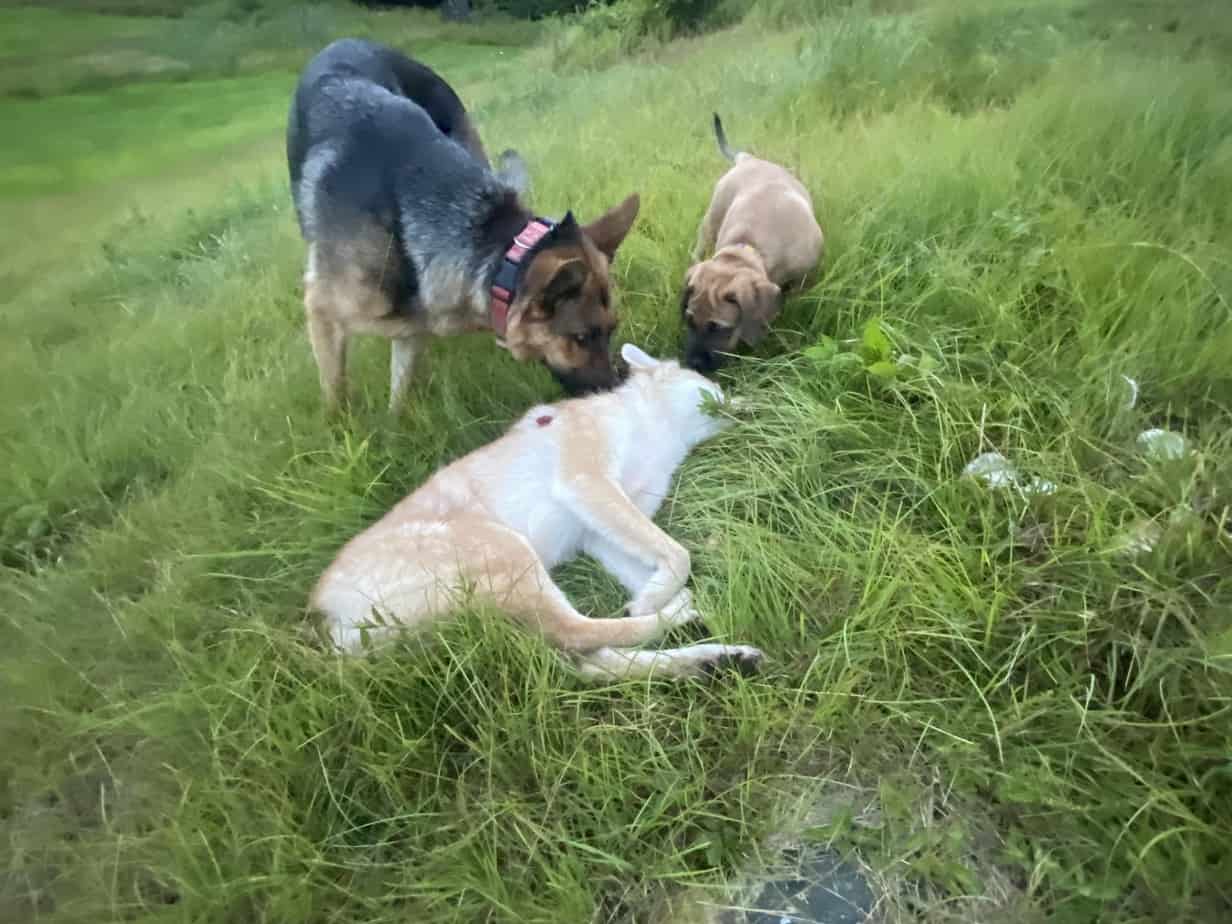
For training purposes only, let’s assume your using a 223 rifle and have selected the 223 Rem 55 gr V-MAX® as your bullet of choice.
At 0-200 yards, the bullet drop is unimportant, and your aiming point on a broadside coyote is dead on the vitals zone.
But at 300 yards? That bullet (aimed at the same vital zone target area) will drop 7 inches and pass under the coyote’s belly. At 400 yards? Your bullet will drop 21 inches and hit the ground somewhere between you and the now fleeing coyote. And at 500 yards? Well, your bullet will drop an astounding 4 feet (okay, 46 inches), and the coyote might not even glance your way if it thinks that’s the best you can do.
To avoid these kinds of misses, learn your bullet’s drop by visiting the manufacturer’s website. For example, here’s the info for the 223 Rem 55 gr V-MAX®.
Once you know your bullet’s drop info, you are ready for the hard part.
Holdover: Where to aim to hit the best place to shoot a coyote.
Holdover is the act of positioning the crosshairs of your reticle above the location of your target to compensate for the bullet’s drop.
To do this, you’ll need to know the range to your target and the bullet’s drop in inches at that range.
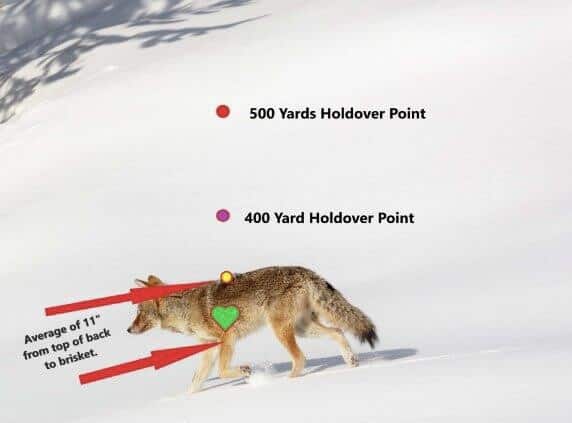
The picture above shows the aiming points (the holdover point) needed to hit a coyote at various long ranges using the Hornady 55gr V-Max. There is no wind factor calculated for this example.
The yellow holdover point (top of the coyote’s back) is for 300 yards. This will allow the 7” drop of the bullet to hit the vital’s zone.
The purple holdover point is for 400 yards (21” drop).
The red holdover point is for 500 yards (46” drop).
You can use the average of 11” height of a coyote from its brisket (bottom of the chest) to the top of its back to help you manually find your holdover.
Coyote shot placement using ATN 4K Pro or ATN Thor 4 Scopes.
Suppose you find it necessary to take long-range shots as a new predator hunter. In that case, the ATN 4K Pro and ATN Thor 4 scopes have ballistic calculators that allow you to determine the range and automatically adjust your reticle to that range.
While I do get a small commission (at no extra charge to you), if you use a link I provide, I own these scopes and recommend them to all new predator hunters.
Both of these scopes let you quickly collect the wind, range, temperature, and other important information and then determine the bullet’s actual path it will take under those conditions. You can then simply aim for the best place to shoot a coyote and pull the trigger (no need for holdover).
Best place to shoot a coyote (when it’s running).
Okay, another “for training purposes only” chapter for new predator hunters. Shooting at a running, or even trotting, coyote is difficult. It’s also potentially dangerous, so be aware of your backstop at all times and don’t let the excitement and that AR get you into trouble.
Here’s a great video on how to do it. All I’d add is to get in the habit of using the minimum magnification needed on your scope and keep the coyote in the reticle at all times.
Remember: The best place to shoot a coyote is in the vitals zone.
Aim to put your round behind the shoulder joint, about 6” above the foreleg. If your shot connects here, you’ll most likely have a DRT coyote. Of course, things do not always go perfectly, but with a bit of practice and good shot placement, you should put some fur in the back of the truck.

